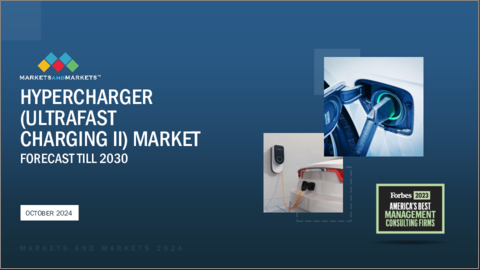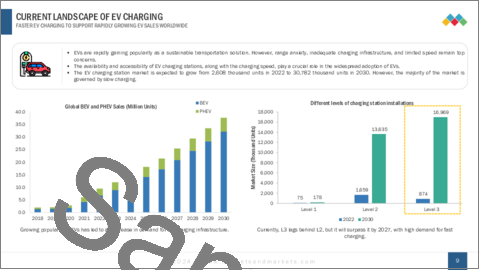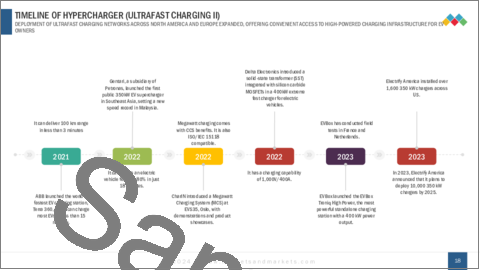|
|
市場調査レポート
商品コード
1420455
ハイパーチャージャーの世界市場 (~2030年):ポートタイプ (CCS・MCS・ChaoJi・NACS)・ハイパーチャージャー対応車販売台数の車両タイプ (乗用車・小型商用車・大型商用車)・地域別Hypercharger Market by Port Type (CCS, MCS, ChaoJi, NACS), Hypercharging Compatible Vehicle Sales by Vehicle Type (Passenger Cars, Light Commercial Vehicle and Heavy Commercial Vehicle), and Region - Global Forecast to 2030 |
||||||
カスタマイズ可能
|
|||||||
| ハイパーチャージャーの世界市場 (~2030年):ポートタイプ (CCS・MCS・ChaoJi・NACS)・ハイパーチャージャー対応車販売台数の車両タイプ (乗用車・小型商用車・大型商用車)・地域別 |
|
出版日: 2023年11月21日
発行: MarketsandMarkets
ページ情報: 英文 50 Pages
納期: 即納可能
|
- 全表示
- 概要
- 目次
レポート概要
| 調査範囲 | |
|---|---|
| 調査対象年 | 2023-2030年 |
| 基準年 | 2022年 |
| 予測期間 | 2023-2030年 |
| 単位 | 数量 (台) |
| セグメント | ポートタイプ (CCS・MCS・ChaoJi・NACS)・ハイパーチャージャー対応車販売台数の車両タイプ (乗用車・小型商用車・大型商用車) |
| 対象地域 | アジア太平洋・北米・欧州 |
世界のハイパーチャージャーの市場規模は、2023年の1万400台から、予測期間中はCAGR59.5%で推移し、2030年には27万3,700台に達すると予測されています。
ポートタイプ別では、ChaoJiの部門が予測期間中に特に高いCAGRで成長すると予測されています。新しい充電規格であるChaojiは、最大900kWの出力を可能にすることで際立っており、高速充電能力の大きな飛躍を意味しています。特筆すべきは、ChaoJiは中国と日本の共同作業であり、ハイパー充電技術の進歩を目指した国境を越えたパートナーシップを反映していることです。ChaoJiの革新的な機能と国際的な協力関係は、ハイパー充電ソリューションの成長を牽引する重要なセグメントとして位置づけられています。
地域別では、北米市場がハイパーチャージャー市場で高い成長の可能性を示しています。北米市場は大きな成長を遂げており、Electrify Americaが戦略的拡大を通じて先導しています。主な協力関係としては、TravelCenters of America (TA) との提携があり、5年間で主要幹線道路沿いの200カ所に約1,000基のDC急速充電器を配備します。Electrify Americaは、充電ステーションの設計と保守の専門家として知られており、TAを自社の充電ネットワークに統合することで影響力を拡大しています。
当レポートでは、世界のハイパーチャージャーの市場を調査し、市場概要、市場影響因子および市場機会の分析、技術動向、法規制環境、主な使用例・ビジネスモデル、市場規模の推移・予測、各種区分・地域別の詳細分析、競合情勢、主要企業のプロファイルなどをまとめています。
目次
第1章 イントロダクション
第2章 調査手法
第3章 エグゼクティブサマリー
第4章 重要考察
第5章 市場概要
- 市場力学
- 促進要因
- 抑制要因
- 機会
- 課題
- エコシステム分析
- バリューチェーン分析
- 技術分析
- さまざまな種類のDC充電の技術ロードマップ
- EV充電の情勢
- 主な使用例
- TCO分析
- メガワット充電の見通し
- ハイパーチャージに向けた電気バスと電気トラックの開発
- 主要なビジネスモデル
- 規制と標準化
- 市場課題の克服
第6章 ハイパーチャージャー対応車の販売台数:車両タイプ別
- 乗用車
- 小型商用車
- 大型商用車
第7章 ハイパーチャージャー市場:ポートタイプ別
- NACS
- CCS
- ChaoJi
- MCS
第8章 ハイパーチャージャー市場:地域別
- アジア太平洋
- 欧州
- 北米
第9章 競合情勢
- 概要
- 主要企業の戦略/有力企業
- 競合ベンチマーキング
第10章 MARKETSANDMARKETSによる推奨事項
第11章 付録
Report Description
| Scope of the Report | |
|---|---|
| Years Considered for the Study | 2023-2030 |
| Base Year | 2022 |
| Forecast Period | 2023-2030 |
| Units Considered | Volume (Thousand Units) |
| Segments | by Port Type (CCS, MCS, ChaoJi, NACS), Hypercharging Compatible Vehicle Sales by Vehicle Type (Passenger Cars, Light Commercial Vehicle and Heavy Commercial Vehicle) |
| Regions covered | Asia Pacific, North America, Europe |
The global Hypercharger market size is projected to grow from 10.4 Thousand Units in 2023 and projected to reach 273.7 Thousand Units by 2030, at a CAGR of 59.5%. Reducing electric vehicle (EV) prices is expected to drive increased demand in the Hypercharger market, primarily due to government support and technology advancements. Governments worldwide are incentivizing the adoption of electric vehicles through subsidies and tax benefits, making EVs more affordable for consumers. Additionally, continuous advancements in hypercharging technology are enhancing charging efficiency and reducing costs, further incentivizing consumers to opt for electric vehicles. The combination of government support and technological progress creates a favorable environment, fostering greater demand for hypercharging solutions in tandem with more affordable electric vehicles.
ChaoJi is estimated to grow at a noticeable CAGR during the forecast period
Chaoji is anticipated to experience significant growth with a noticeable (CAGR) during the forecast period in the Hypercharger market. As a new charging standard, Chaoji stands out by enabling outputs of up to 900 kW, signifying a major leap forward in high-speed charging capabilities. Notably, ChaoJi is a collaborative effort between China and Japan, reflecting a cross-border partnership aimed at advancing hypercharging technology. The innovative features and international collaboration associated with Chaoji position it as a key segment in driving the growth of hypercharging solutions.
North America Region shows high growth potential for Hypercharger market
The Hypercharger market in North America is experiencing significant growth, with Electrify America leading the way through strategic expansions. A key collaboration involves a partnership with TravelCenters of America (TA) to deploy around 1,000 DC fast chargers at 200 locations along major highways over five years. Electrify America, recognized for its expertise in designing and maintaining charging stations, extends its influence by integrating TA into its charging network. This collaboration, along with other industry partnerships, underscores Electrify America's pivotal role in expanding high-speed charging accessibility throughout North America.
In-depth interviews were conducted with CEOs, marketing directors, other innovation and technology directors, and executives from various key organizations operating in the Hypercharger market. The break-up of the primaries is as follows:
- By Company Type: OEMs - 24%, Tier 1 - 67%, and Others - 9%
- By Designation: C Level Executives - 33%, Managers - 52%, and Others - 15%
- By Region: North America - 40%, Europe - 26%, and Asia Pacific - 34%
The Hypercharger market comprises major players such as ABB (Switzerland), Electrify America (US), Heliox (Netherlands), Tritium (Australia) and IONITY (Germany), etc.
Research Coverage:
The study covers the Hypercharger market across various segments. It aims at estimating the market size and future growth potential of this market across different segments such as vehicle type, port type, and region. The study also includes an in-depth competitive analysis of key market players, their company profiles, key observations related to recent developments.
This research report categorizes Hypercharger Market Port type (CCS, NACS, MCS and ChaoJi), Hypercharger compatible vehicle sales by vehicle type (Passenger Cars, Light Commercial Vehicles and Heavy Commercial Vehicles) and Region (Asia Pacific, Europe, North America).
Reasons to buy this report:
The study also includes an in-depth competitive analysis of the key players in the market, along with their company profiles, key observations related to product and business offerings, recent developments, and key market strategies.
The report will help the market leaders/new entrants in this market with information on the closest approximations of the revenue numbers for the overall Hypercharger market and the subsegments. This report will help stakeholders understand the competitive landscape and gain more insights to position their businesses better and to plan suitable go-to-market strategies. The report also helps stakeholders understand the market pulse and provides information on key market drivers, restraints, challenges, and opportunities.
The report provides insights on the following pointers:
- Analysis of key drivers (Increase in adoption of Electric Vehicles), restraints (DC Fast Chargers Can overload the grid), opportunities (Electric Truck and Bus Segment witnessing Developments Towards Hyper Charging), and challenges (Inadequate charging infrastructure in rural areas) influencing the growth of the Hypercharger market.
- Product Development/Innovation: Detailed insights on upcoming technologies, research & development activities, and new product & service launches in the Hypercharger market
- Market Development: Comprehensive information about lucrative markets - the report analyses the Hypercharger market across varied regions.
- Market Diversification: Exhaustive information about new products & services, untapped geographies, recent developments, and investments in the Hypercharger market
- Competitive Assessment: In-depth assessment of growth strategies, and service offerings of leading players like ABB (Switzerland), Electrify America (US), Heliox (Netherlands), Tritium (Australia) and IONITY (Germany), others in the Hypercharger market.
TABLE OF CONTENTS
1. INTRODUCTION
- 1.1 OBJECTIVES OF THE STUDY
- 1.2 MARKET DEFINITION
- 1.2.1 INCLUSIONS & EXCLUSIONS
- 1.3 MARKET SCOPE
- 1.3.1 YEARS CONSIDERED FOR THE STUDY
- 1.4 STAKEHOLDERS
2. RESEARCH METHODOLOGY
- 2.1 RESEARCH DATA
- 2.1.1 SECONDARY DATA
- 2.1.1.1 Key secondary sources
- 2.1.1.2 Key data from secondary sources
- 2.1.2 PRIMARY DATA
- 2.1.2.1 List of primary participants
- 2.1.1 SECONDARY DATA
- 2.2 MARKET SIZE ESTIMATION
- 2.2.1 BOTTOM-UP APPROACH
- 2.2.2 TOP-DOWN APPROACH
- 2.3 DATA TRAINGULATION
- 2.4 FACTOR ANALYSIS
- 2.5 RESEARCH ASSUMPTIONS
- 2.6 RESEARCH LIMITATIONS
3. EXECUTIVE SUMMARY
4. PREMIUM INSIGHTS
5. MARKET OVERVIEW
- 5.1 INTRODUCTION
- 5.2 MARKET DYNAMICS
- 5.2.1 DRIVERS
- 5.2.2 RESTRAINTS
- 5.2.3 OPPORTUNITIES
- 5.2.4 CHALLENGES
- 5.3 ECOSYSTEM ANALYSIS
- 5.4 VALUE CHAIN ANALYSIS
- 5.5 TECHNOLOGY ANALYSIS
- 5.6 TECHNOLOGY ROADMAP OF DIFFERENT KINDS OF DC CHARGING
- 5.7 CURRENT LANDSCAPE OF EV CHARGING
- 5.8 KEY USE CASES
- 5.9 TCO ANALYSIS
- 5.10 PROSPECTS OF MEGAWATT CHARGING
- 5.11 ELECTRIC BUS AND TRUCKS DEVELOPMENTS TOWARDS HYPERCHARGING
- 5.12 KEY BUSINESS MODELS
- 5.13 REGULATORY AND STANDARDIZATION
- 5.14 OVERCOMING CHALLENGES IN THE MARKET
6. HYPERCHARGING COMPATIBLE VEHICLE SALES BY VEHICLE TYPE
- 6.1 INTRODUCTION
- 6.2 PASSENGER CARS
- 6.3 LIGHT COMMERCIAL VEHICLES
- 6.4 HEAVY COMMERCIAL VEHICLES
7. HYPERCHARGER MARKET, BY PORT TYPE
- 7.1 INTRODUCTION
- 7.2 NACS
- 7.3 CCS
- 7.4 CHAOJI
- 7.5 MCS
8. HYPERCHARGER MARKET, BY REGION
- 8.1 INTRODUCTION
- 8.2 ASIA PACIFIC
- 8.2.1 CHINA
- 8.2.2 JAPAN
- 8.2.3 SOUTH KOREA
- 8.2.4 INDIA
- 8.2.5 VIETNAM
- 8.2.6 THAILAND
- 8.2.7 INDONESIA
- 8.2.8 MALAYSIA
- 8.3 EUROPE
- 8.3.1 GERMANY
- 8.3.2 FRANCE
- 8.3.3 UK
- 8.3.4 SPAIN
- 8.3.5 AUSTRIA
- 8.3.6 NETHERLANDS
- 8.3.7 SWEDEN
- 8.3.8 NORWAY
- 8.3.9 DENMARK
- 8.4 NORTH AMERICA
- 8.4.1 US
- 8.4.2 CANADA
9. COMPETITIVE LANDSCAPE
- 9.1 OVERVIEW
- 9.2 KEY PLAYER STRATEGIES/ RIGHT TO WIN
- 9.3 COMPETITIVE BENCHMARKING






